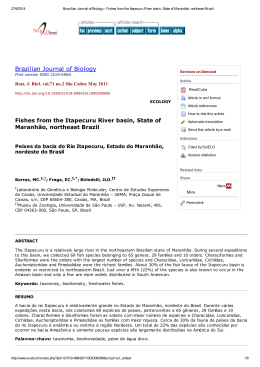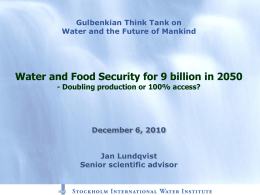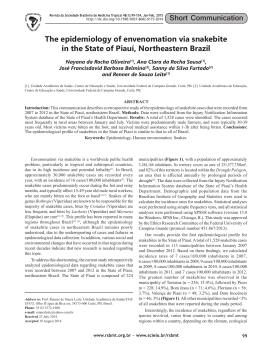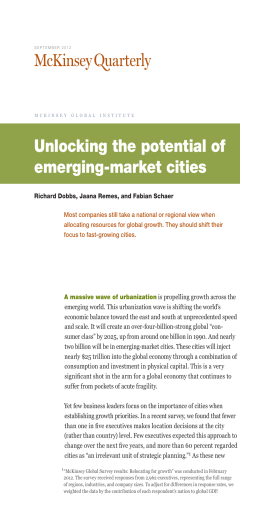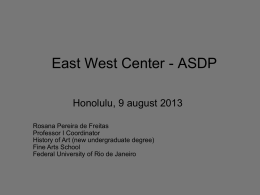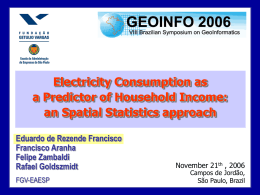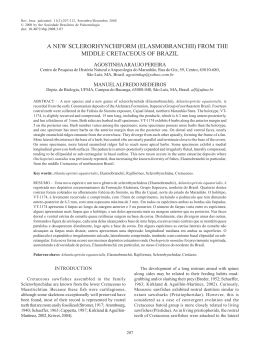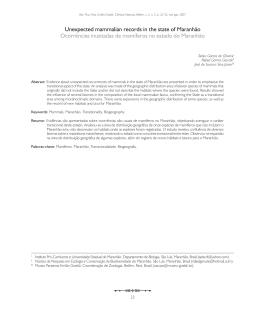BRAZILIAN OVERVIEW ON KEY ISSUES Brazil UK Startup Meeting Oxford Brookes – May 18 2010 Structure • • • Some general features of the Brazilian urban and regional development trajectory Territorial and productive restructuring and the emergence of new state spaces – some observations on Brazil Issues for discussion – the network Brazilian cities Population range More than 350.000 No. of Municipalities Population GDP % of Municipalities % of population % GDP 61 64.144.341 1.154.239.615,82 1,10% 34,86% 48,71% 50.000 – 350.000 505 56.339.642 722.094.340,97 9,08% 30,62% 30,47% 20.000 – 50.000 994 29.986.945 247.262.066,34 17,87% 16,30% 10,43% Less than 20.000 4.003 33.513.562 246.178.486,09 71,96% 18,22% 10,39% Total 5.563 183.984.490 2.369.774.509,21 100,00% 100,00% 100,00% Concentration, polarization and uneven development The Brazilian UrbanNetwork – (IBGE) Human Development % of people older than 15, with less than 4 years of school (Base – 2000) Participation of cities in the GDP (2006) 25% of the national GDP is located in 5 cities 50% of the national GDP is located In 50 municípios Participação dos Municípios no PIB Brasileiro 75% of the GDP in 300 cities 85% of the GDP in 751 cities Participação dos Municípios no PIB Brasileiro 95% of the GDP in 2202 cities 99% of the GDP in 4205 cities Participation (%) of the main city networks in the GDP, agrobussiness, industry and services – 2002/2006 Economic development has spread over the last decades, but there are limits to macro-spatial deconcentration outside the south-eastern/southern states Red dots: Intense Dynamism (% growth of city GDP) Red dots: very low income cities with very high dynamism NOME_UF Maranhão Maranhão Maranhão Maranhão Maranhão Maranhão Maranhão Maranhão Piauí Piauí Piauí Piauí Piauí Piauí Piauí Sergipe Bahia Bahia Minas Gerais Mato Grosso MUNIC Anapurus Bom Jardim Centro Novo do Maranhão Igarapé do Meio Luís Domingues Pirapemas Porto Franco Serrano do Maranhão Assunção do Piauí Baixa Grande do Ribeiro Currais Manoel Emídio Santa Filomena Santo Antônio de Lisboa Sebastião Leal Capela Barrocas Sátiro Dias Grão Mogol Curvelândia Red dots - Very high income cities with a very high level of dynamism dinâmicos NOME_UF Rio Grande do Nort Minas Gerais Minas Gerais Minas Gerais Minas Gerais Minas Gerais Espírito Santo Rio de Janeiro Rio de Janeiro Rio de Janeiro São Paulo São Paulo São Paulo São Paulo São Paulo São Paulo Santa Catarina MUNIC Guamaré Araporã Nova Ponte Ouro Branco São João Batista do Glória São José da Barra Anchieta Armação dos Búzios Campos dos Goytacazes Quissamã Alumínio Ariranha Estrela d'Oeste Jaguariúna Motuca São Caetano do Sul Treze Tílias Red dots: High income cities with dynamism Very low Income Cities With dynamism These are 454 cities concentrated in the NE states and the Amazonia Other features of the urban development trajectory Growth and increasing density of the periphery of the metropolitan areas, state capitals and larger urban poles in the country, characterized by a pattern of unequal acess to land and urban services, and environmental degradation Deterioration and derelict areas in the central areas of larger cities and metropolitan areas The opening up of new urban-peri-urban rural frontiers in the central–eastern and Amazone regions (agrobusiness etc.) triggers environmental and land based conflicts, lack of urbanity and conflicts with indigenous population Other features of the urban development trajectory (ctd) Urban economic growth and population inflow of cities located in resource rich areas (minerals, agro-business, petrol), frequently generating environmemntal degradation, intense land based conflicts and relocation of indigenous communities Urban economic growth of city regions that polarize, both along the coastal zones as well in the interior regions of the country (satelite – platforms?) – cities located along the Amazon river, along the highway Brasília-Cuiabá-Porto Velho-Rio Branco, Belém-Brasília and, more recently, the highway, Cuiabá-Santarém. Territorial and productive restructuring and the emergence of new state spaces – some observations on the Brazilian scenario From Spatial keynesianism... Spatial Keynesianism STATE SPATIAL PROJECTS STATE SPATIAL STRATEGIES SCALAR DIMENSION State administrative and regulatory capacities are centralized around the national scale: regions and localities are subordinated to the macroeconomic and macro-redistributive imperatives of the (national) center The national scale is promoted as the most essential level of politicaleconomic life: the national economy thus becomes "the essential geographical unit of economic organization, accumulation, and regulation over which the state is the sovereign actor" TERRITORIAL DIMENSION Redistributive policies are mobilized in Relatively uniform structures of order to equalize the distribution of territorial administration are established industry and infrastructure investment throughout the national space-economy: across the national space-economy: "in "consistent standards of social welfare most countries, postwar Keynesian and social infrastructure provision (are interventionism was a key factor behind established) across regions and the steady process of regional localities, thereby incorporating them convergence in per capita incomes that into an increasingly collective or public characterized most advanced capitalist space-economy" nations until the late 1970s" Source: Brenner, 2004: 132, Figure 4.2 To rescaled, competitive state spatial regimes....? Urban locational Policies in Western-Europe SCALAR DIMENSION TERRITORIAL DIMENSION STATE SPATIAL PROJECTS STATE SPATIAL STRATEGIES Tendential decentralization of state administrative arrangements towards subnational tiers of national authority. Regional and local state institutions aquire new responsabilities in the development, financing and implementation of economic development p Increasing localization of socioeconomic assets as national, regional and local state institutions attempt to enhance territorial competitiveness within strategic urbanized spaces. Cities and cityregions are viewed as key geographical engines of economic Increasing customization of state spatial arrangements according to place and jurisdiction-specific conditions and priorities. This generates an increased differentiation of local and regional institutional forms and an enhanced divergence of local and r Increasing differentiation of national political-economic spaces as state institutions attempt to channel major socioeconomic assets and advanced infrastructure investments into the most globally competitive urban and regional spaces. This generates an in Source: Brenner, 2004: 214, Figure 5.8 Brazil in the 1990s Opening up of the Brazilian macroeconomic framework, without compensating industrial, technological and regional development policies Colapse of the national developmental regime Neo-localist regimes, tax wars, regulatory downgrading, federal government laissez-faire Competitive federal relations (states, cities) More recently, however..... Advances in federal housing and urban development policies – creation of the ministry, statute of the city, institutionalization of participatory structures (conselho das cidades), substantial increases in financial resources for the housing and urban development sector (PAC, Minha casa minha vida); Metropolitan agenda is being taken up again (new law on public consortia etc.) Nevertheless, progress is said to be slow.... Application of the statute of the city is slow – vested interests in real estate markets Federal programs and financial resources often “bypass” the institutional and participatory structures that have been created; There is no national program for metropolitan governance Issues for the network and the research Urban environmental justice – combining the urban/housing and the green agenda in an inclusive and sustainable manner – last few years – after convergence there are increasing conflicts (e.g environmental versus the housing movements); Metropolitan governance and nation building in a post – keynesian scenario? – going beyond socio-institutional engineering – multi-scalar policies; Regional development in an increasingly fragmented national space economy – archipelago economies in resource rich frontier regions – urban-peri-urban rural linkages without a national framework – from “macro-regional” to new regionalist regional policies? Last but not least.... Linking the urban policy agenda with climate change Limits, potentials, threats and risks – what is the role of cities in the debate (the scalar issue); How to set goals and targets Instruments – economic and regulatory instruments – leakages associated with city activism; Welfare economic considerations – where to tax (production chains and resource intensive regions)/how to evaluate policy instruments? Political economy framework – who gains/who loses?
Download








